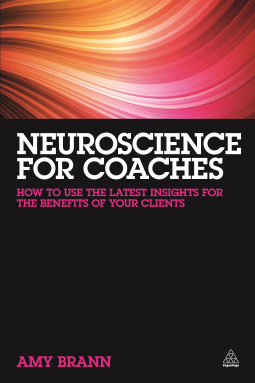Neuroscience for Coaches is the perfect introductory text for people in counseling and coaching who are not from a medical background. Neuroscience for Coaches is detailed enough to give you a basic understanding of brain anatomy and written in an informal writing style as compared to other medical texts. The author takes care to explain most of the medical terms to ensure that readers are not lost. Moreover, the glossary at the end of the book can work as a ready reference until the reader becomes familiar with the anatomy and chemicals in the brain.
Amy Brann studied medicine at University College London. At Synaptic Potential, she works with companies to help them better understand their teams, clients, and organizations as a whole. Brann is the creator of the online community, “Neuroscience in Business” and has been the Lead Coach for Europe for one of the largest NLP Training Companies in the world.
 Neuroscience for Coaches: How to Use the Latest Insights for the Benefit of Your Clients
Neuroscience for Coaches: How to Use the Latest Insights for the Benefit of Your Clients
Author Amy Brann
Paperback: 232 pages
Publisher: Kogan Page (November 28, 2014)
ISBN-10: 0749472375
ISBN-13: 978-0749472375
The book follows a well-defined structure, where the author introduces a specific part of the human brain, explains its functions, and then talks about how it specifically affects human behavior and emotions. After that, Brann evaluates why this specific information is important for coaches and stresses its significance by giving some real-world examples.
The author rightfully sticks to parts that are relevant to human behavior and can help coaches influence their client’s success or failure. All the parts that mainly handle the motor functions are not included thereby maintaining the focus of the topic.
But human brain is much more complex than functioning of the physical anatomy. The chemical composition and various hormone secretions affect how the physical parts interact with each other. The middle portion of the book looks into some of the most important chemicals such as Dopamine, Serotonin, and GABA, which along with the glutamates regulate your brain’s messenger service.
Ever wondered how mass panic or excitement builds so fast? You could blame that on mirror neurons. In Chapter 21, Mirror Neurons, Brann discusses the theory behind how people in a group start imitating other people’s behavior. Coaches who become aware of this mirror neuron behavior concept can help their clients take corrective action in a stressful situation. With this knowledge, coaches can help their clients resolve conflicts rather than make them add to the collective behavior. Apart from introducing new concepts, Brann also explains the neuroscience of more traditional coaching approaches and ties it with all the theory discussed earlier in the book.
![]() I believe Neuroscience for Coaches is an excellent source for counselors and coaches who advise their clients on how to handle stress, overcome inhibitions, and lead a fulfilling life. The theory discussed in the book gives a physiological basis for human actions and the coaches can fine tune their advice and create a multipronged solution for their clients. The book can also prove useful to managers who wish to expand their understanding of human behavior, which will help them effect positive changes in their team.
I believe Neuroscience for Coaches is an excellent source for counselors and coaches who advise their clients on how to handle stress, overcome inhibitions, and lead a fulfilling life. The theory discussed in the book gives a physiological basis for human actions and the coaches can fine tune their advice and create a multipronged solution for their clients. The book can also prove useful to managers who wish to expand their understanding of human behavior, which will help them effect positive changes in their team.